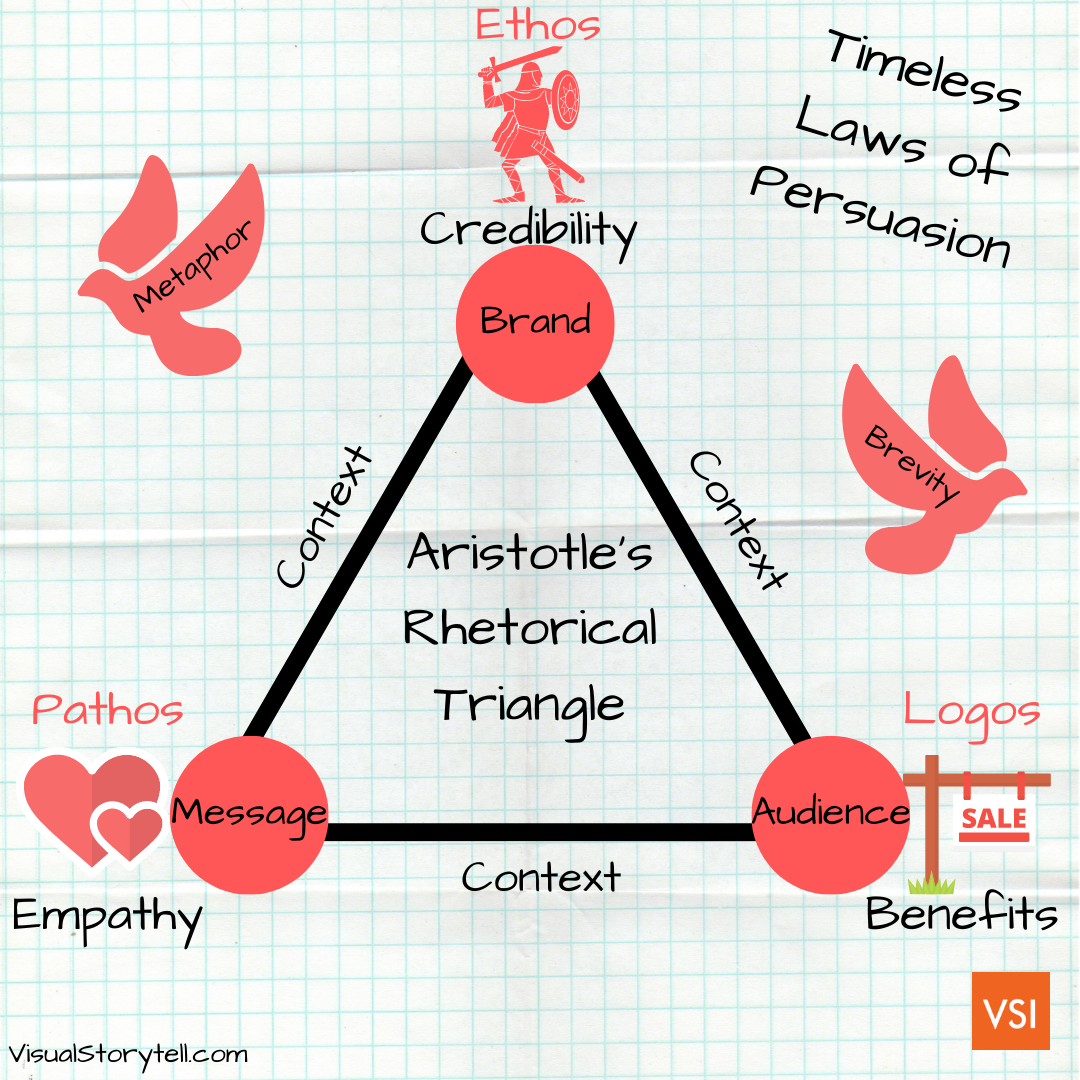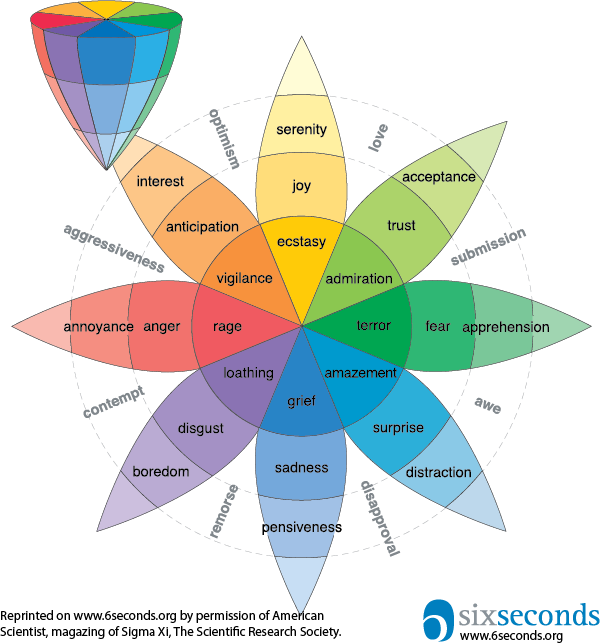
Don’t let a lack of Persuasion Weaken your Story’s Impact
Don’t let a lack of Persuasion Weaken your Story’s Impact https://www.visualstorytell.com/wp-content/uploads/2019/07/persuasion_thumb.jpg 366 218 Shlomi Ron Shlomi Ron https://secure.gravatar.com/avatar/995c0cf093380b90c7704fda398c9addf4e5c605afbc92af5c3f01f67d65aa41?s=96&d=mm&r=g
What is your persuasion strategy to move your audience into action?
Sometimes it’s worth looking back, actually quite back – more than 2000 years ago – when Aristotle shared his timeless persuasion formula in his work Rhetoric.
As you can see from the infographic below, Aristotle’s Rhetorical Triangle consists of three persuasion drivers:
1) Ethos
Refers to the character or credibility of the brand, the communicator. Your audience is constantly looking to make sense of the world around them and assign a meaning to inform their decisions if a stranger is a friend or foe. It’s an ancient survival mechanism we all still carry. To earn your audience trust, you need to communicate credibility factors. Storytelling expert, Annette Simmons suggests using the following stories to build your credibility:
a) Who I am story? (Who are you? What makes you special? What earns you the right to influence?)
b) Why I am here story? (Why you do what you do?)
 At the end of the day, the purpose of any message you communicate is to persuade.
At the end of the day, the purpose of any message you communicate is to persuade.
That means, changing the story your customers tell themselves about your product
– to your story’s version.
More than 2000 years ago, the core persuasion drivers Aristotle discovered in his work, Rhetoric
– are still relevant today.
For more visual storytelling tips, follow us on Instagram
2) Pathos
To win the hearts of your audience, you need to use emotions in your story. I already wrote about the metaphor of Total Eclipse to indicate the magical moment when your story stops becoming your story and becomes your audience’s story. Your story is nothing but a mirror. It will emotionally move your audience only when it will reflect a total eclipse between your story and past experiences from your customer’s personal story.
“I’ve learned that people will forget what you said, people will forget what you did,
but people will never forget how you made them feel.”
― Maya Angelou
So, when you plan your story make sure you focus on a single emotion to maximize empathy and grow trust. You can select a single emotion from Robert Plutchik’s 8 emotion types:
 3) Logos
3) Logos
Refers to proof points you use in your story to win your audience’s minds – appeal to reason. These attributes are in essence benefits or incentives that establish “what’s in it for your audience?” Would your product save money or time or effort for your customer? Communication expert, Carmine Gallo aptly summarizes: “Why should your audience care about your idea? If it will save your audience money, for example, they’ll want to know how much it will save them and how the savings will be accomplished. The same reasoning applies to making money. How will your idea help your listeners earn a profit? What steps do they have to take next?”
4) Metaphor
Merriam-Webster dictionary defines a metaphor as “a figure of speech in which a word or phrase literally denoting one kind of object or idea is used in place of another to suggest a likeness or analogy between them (as in drowning in money).” Or consider this explanation for our context; a metaphor works like nifty night vision goggles and allows your audience to see in low-light conditions, where low light conditions represent new unfamiliar information you include in your story. A metaphor simplifies a complex new piece of information and this boosts your message comprehension. It’s best to start your message with an introductory metaphor to boost initial engagement. Make sure you also call out elements from your opening metaphor even after you transition into the depth of your new materials. It will revive comprehension and keep your audience’s attention high.
5) Brevity
Aristotle wraps up his list of key persuasion drivers with the need to keep your story sweet and short. Why? Simple, your audience’s attention span is at its highest in your opening and decreases as time goes by. That’s why it’s so critical to start your story with a splash or very simple metaphor in order to maximize your audience’s attention and engagement.
Finally, to achieve the highest persuasion impact, I recommend baking these drivers in a story format that will show vs. tell these persuasion values in action.
Having said that, the connecting tissue that goes through all three drivers is – context.
Put simply, think about how your visual storytelling strategy will change with these contextual elements: your buyer persona type, her stage in the buyer’s journey, storyteller perspective, and the platform culture you tell your story on.
Need help? Feel free to throw some time on my calendar and I’d be happy to discuss.
- Post Tags:
- Aristotle
- persuasion
- rhetoric
- Posted In:
- Story Making
- Story Telling
- Visual Storytelling
Shlomi Ron
Shlomi Ron is the founder and CEO of the Visual Storytelling Institute, a Miami-based think tank with a mission to bring the gospel of visual storytelling from the world of art to more human-centric and purpose-driven marketing. A digital marketing veteran with over 20 years of experience working both on the agency and brand sides for Fortune 100/500 brands such as Nokia, IBM, and American Express. He started VSI to combine his marketing expertise with his passion for visual stories stemming from his interests in classic Italian cinema and managing the estate of video art pioneer, Buky Schwartz. At VSI, he helps brands rise above the communication noise through visual storytelling consulting, training, and thought leadership. Select clients include Estée Lauder, Microsoft, and Cable & Wireless – to name a few. He currently teaches Brand Storytelling at the University of Miami’s Business School. Thought leader and speaker at key marketing conferences. He is also the host of the Visual Storytelling Today podcast, which ranks in the top 10 best business storytelling podcasts on the Web. His book: Total Acuity: Tales with Marketing Morals to Help You Create Richer Visual Brand Stories. Outside work, he is a nascent bread baker, The Moth fan, and longtime fedora wearer likely to jive with his classic Italian cinema interest.
All stories by: Shlomi Ron2 comments
This site uses Akismet to reduce spam. Learn how your comment data is processed.


Leave a Reply